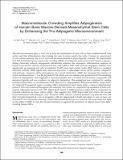Macromolecular Crowding Amplifies Adipogenesis of Human Bone Marrow-Derived Mesenchymal Stem Cells by Enhancing the Pro-Adipogenic Microenvironment
Author(s)
Ang, Xiu Min; Lee, Michelle H.C.; Blocki, Anna; Chen, Clarice; Ong, Lee Ling; Sheppard, Allan; Raghunath, Michael; Asada, Harry; ... Show more Show less
DownloadAsada_Macromolecular crowding.pdf (2.123Mb)
PUBLISHER_POLICY
Publisher Policy
Article is made available in accordance with the publisher's policy and may be subject to US copyright law. Please refer to the publisher's site for terms of use.
Terms of use
Metadata
Show full item recordAbstract
The microenvironment plays a vital role in both the maintenance of stem cells in their undifferentiated state (niche) and their differentiation after homing into new locations outside this niche. Contrary to conventional in-vitro culture practices, the in-vivo stem cell microenvironment is physiologically crowded. We demonstrate here that re-introducing macromolecular crowding (MMC) at biologically relevant fractional volume occupancy during chemically induced adipogenesis substantially enhances the adipogenic differentiation response of human bone marrow-derived mesenchymal stem cells (MSCs). Both early and late adipogenic markers were significantly up-regulated and cells accumulated 25–40% more lipid content under MMC relative to standard induction cocktails. MMC significantly enhanced deposition of extracellular matrix (ECM), notably collagen IV and perlecan, a heparan sulfate proteoglycan. As a novel observation, MMC also increased the presence of matrix metalloproteinase −2 in the deposited ECM, which was concomitant with geometrical ECM remodeling typical of adipogenesis. This suggested a microenvironment that was richer in both matrix components and associated ligands and was conducive to adipocyte maturation. This assumption was confirmed by seeding undifferentiated MSCs on decellularized ECM deposited by adipogenically differentiated MSCs, Adipo-ECM. On Adipo-ECM generated under crowding, MSCs differentiated much faster under a classical differentiation protocol. This was evidenced throughout the induction time course, by a significant up-regulation of both early and late adipogenic markers and a 60% higher lipid content on MMC-generated Adipo-ECM in comparison to standard induction on tissue culture plastic. This suggests that MMC helps build and endow the nascent microenvironment with adipogenic cues. Therefore, MMC initiates a positive feedback loop between cells and their microenvironment as soon as progenitor cells are empowered to build and shape it, and, in turn, are informed by it to respond by attaining a stable differentiated phenotype if so induced. This work sheds new light on the utility of MMC to tune the microenvironment to augment the generation of adipose tissue from differentiating human MSCs.
Date issued
2013-12Department
Massachusetts Institute of Technology. Department of Mechanical EngineeringJournal
Tissue Engineering Part A
Publisher
Mary Ann Liebert, Inc.
Citation
Ang, Xiu Min, Michelle H.C. Lee, Anna Blocki, Clarice Chen, L.L. Sharon Ong, H. Harry Asada, Allan Sheppard, and Michael Raghunath. “Macromolecular Crowding Amplifies Adipogenesis of Human Bone Marrow-Derived Mesenchymal Stem Cells by Enhancing the Pro-Adipogenic Microenvironment.” Tissue Engineering Part A 20, no. 5–6 (March 2014): 966–981. © 2012 Mary Ann Liebert, Inc.
Version: Final published version
ISSN
1937-3341
1937-335X